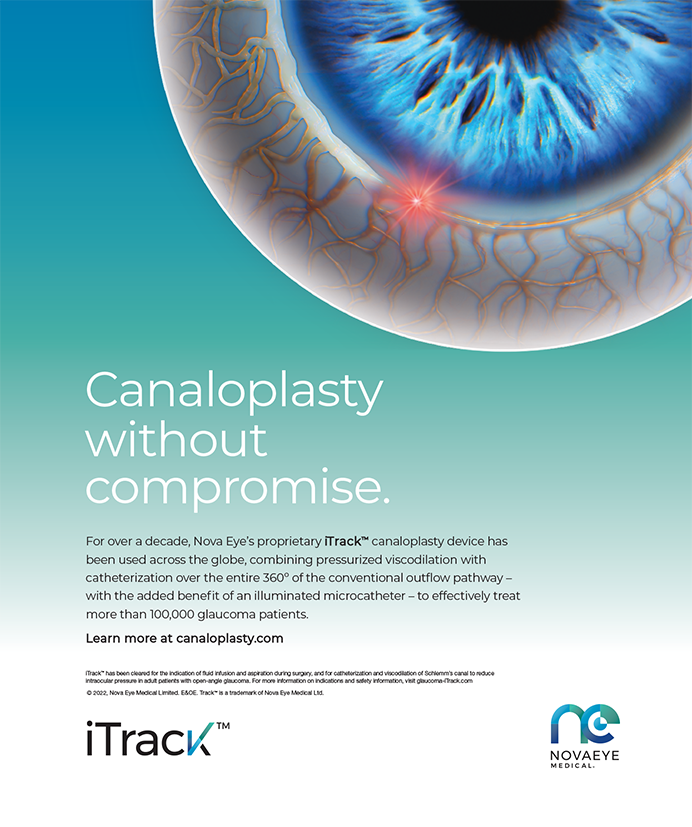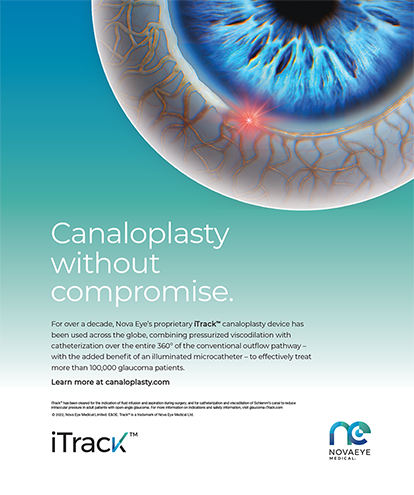Meibomian gland dysfunction (MGD) is believed to be one of the most common sources of patients’ complaints in eye care practices.1 Although estimates vary, MGD may be a contributing factor in more than 60% of all dry eye sufferers.2 MGD continues to be identified in a large percentage of the patient population and consequently, differentiating MGD from other dry eye diseases still remains an underlying issue.
Because the roles of the tear film and the meibomian glands are intricately linked in preserving the health of the ocular surface, it can be difficult to separate blepharitis, MGD, and evaporative dry eye disease3 with regard to pathophysiology and clinical management.1 Despite these challenges, differentiating dry eye etiologies and assessing structural eyelid abnormalities that provoke irritation are paramount to delivering tailored treatments. Ocular surgery has advanced by leaps and bounds in recent years, but even such improvements cannot eliminate the risk of postoperative problems. Surgeons can limit the incidence of postsurgical complications by communicating the importance of lid hygiene to referring practitioners and patients.
CLASSIFICATION OF MGD
Blepharitis is generally known as inflammation of the eyelids, and in most cases, there is some involvement of the meibomian glands. MGD is a subset of the conditions that fall under the blepharitis rubric,4 but MGD and blepharitis are different conditions. MGD may not be sight-threatening, but it does generate noticeable discomfort. Abnormal lipids produced by patients with MGD have a negative effect on the quality of the tear film, may produce discomfort, and may affect outcomes in ocular surgery.2,5,6
A slit-lamp examination of an MGD patient will often reveal inspissated glands, gland dropout, and lid inflammation. Normal meibum is typically a clear fluid and influences the evaporation rate of the tear film. Discrepancies in the meibum, such as a thick, yellowish secretion with pressure to the lid, are signs of MGD. Less obvious signs may include abnormal quality and/or quantity of meibum. If noted, this necessitates gland expression using mild pressure to the lid just below the lash line.
Patients with MGD may present without symptoms, as shown by Blackie et al.5 Although it is generally believed that MGD presents with obvious signs, most specifically inflammation, research suggests a new form of MGD where signs of pathology may be limited or even nonexistent. Nonobvious obstructive MGD is the new term used to describe the most common form of obstructive MGD. This is important because it seems to be the precursor to obvious obstructive MGD, which is recognized to be the most common cause of evaporative dry eye.5
ESTABLISHING CRITERIA
In addition to a lack of agreement among eye care professionals on exact diagnostic criteria, difficulty in the diagnosis of MGD may be attributed to the varying signs and symptoms from patient to patient. MGD is often under- and misdiagnosed, or if diagnosed, it may not be treated until the condition is severe or chronic. Understanding the need for a baseline set of diagnostic criteria, Japanese researchers reported an evaluation of several criteria:6
• ocular symptom score from 0 to 14, based on the number of symptoms the patient indicated from a list of 14 (eg, discharge, foreign body sensation, dryness, sticky sensation)
• lid margin abnormalities, graded from 0 to 4, depending on the presence of abnormal characteristics (irregularity of the lid margin, vascular engorgement, plugged meibomian glands, and apparent anterior or posterior movement of the mucocutaneous junction)
• meibomian gland change scored from 0 (no meibomian gland loss) to 3 (gland loss over 2/3 of the total area of glands) determined using noncontact meibography on the upper and lower lids (total sum scoring 0 to 6 per eye)
• superficial punctate keratopathy graded from 0 to 3
• meibum volume and quality following expression using digital pressure device, graded on a scale from 0 (clear and easily expressed) to 3 (no meibum expressed) per lid
• Schirmer test as an indicator of tear production
• assessment of tear film breakup time, taking the median value of three consecutive measurements after fluorescein instillation
With regard to these findings, MGD diagnosis should be based on ocular symptoms, lid margin abnormality, and meibum quality/quantity. If two out of three of these scores are abnormal, obstructive MGD should be suspected. If all three are abnormal, obstructive MGD is the likely diagnosis.
To assist in the preoperative process and to ease any postoperative complications, ophthalmologists should prompt referring practitioners to use a simple systematic approach to diagnosing and treating MGD. The method I prefer can simply be remembered with the acronym SET: scan, express, treat.
The initial step is to scan the eyelid margin for abnormalities, including plugged glands, excessive redness, or foamy secretions. Clinicians should urge the patient to recall any symptoms pertinent to MGD, such as crusty debris, burning, tearing, and redness or dryness, especially in the morning. An initial consensus regarding symptoms and gland irregularities will allow the eye care provider to form a basic understanding of the patient’s diagnosis.
Next, the clinician should express the glands using a clean fingertip, sterile cotton tip, or other solid, sterile instrument to apply pressure. If an evaluation of meibum quantity and quality reveals discolored secretions and significantly small secretion volumes, it may be indicative of MGD. Secretions should be seen within 10 seconds, but patience is a virtue when it comes to gland expression with older patients who may exhibit decreased elasticity.
Finally, if the patient demonstrates the signs and symptoms of MGD, the clinician should treat accordingly, ensuring that the treatment regimen is different from other forms of dry eye. There are several reasons why it is important to treat MGD, especially in those patients who will be undergoing ocular surgery. First, in patients who will be undergoing an intraocular surgical procedure, it is important to eliminate inflammation and bacteria on the lids and ocular surface, as the bacterial flora can act as a potential source of infecting organisms.7 Studies have shown that the most frequent source of organisms that cause endophthalmitis is the patient’s own lid and surface flora.8 Therefore, eliminating these as a potential source will likely guard against the most dreaded complication of intraocular surgery. Second, with the stress of surgery on the visual system, even the mildest tear film abnormality can result in a significant reduction in the quality of vision and patients’ satisfaction. Proper ocular surface and lid margin treatment is therefore critical to patients’ outcomes, especially among those electing advanced-technology IOLs such as presbyopia-correcting lenses or undergoing corneal laser refractive surgery.
Although there is no FDA-approved therapy specifically for MGD, clinicians generally adhere to a variety of useful treatments such as lid hygiene using lid scrubs, warm compresses, or lid massage. Other standard treatment includes tear substitutes; the off-label or over-the-counter use of topical antibiotics, steroids or combination products; and dietary supplementation with omega-3 fatty acids. Clinicians may opt to help balance the lipid layer and restore the natural tear film with an ocular lubricant targeted at MGD such as the recently released Systane Balance (Alcon Laboratories, Inc.). In a study of patients with dry eye diagnosed with MGD, Systane Balance was preferred over the patients’ habitual therapy.9 There was a statistically significant improvement in the reduction of several common signs and symptoms related to dry eye. Tear film breakup time and corneal staining were improved by 34% and 26%, respectively. Patient-reported responses regarding product satisfaction showed measurable quality-of-life improvements in favor of the treatment group.9
THE BEST REQUIRED FOR PATIENTS’ CARE
Surgeons are prepared with a skill set that can significantly improve a patient’s life. The results of perfectly, and meticulously performed surgery may be compromised by an abnormal ocular surface. The importance of educating referring practitioners to properly diagnose and treat MGD at the time of referral and the surgeon’s recognition of the signs and symptoms are vital for a successful outcome. Careful attention to the lid margins should now be a critical component in the care of the surgical patient. Healthy lid margins and a normal ocular surface help ensure that surgery is not delayed as a result of therapeutic intervention, outcomes are not compromised, and excellent satisfaction for the patient is attained.
Stephen S. Lane, MD, is a managing partner of Associated Eye Care in St. Paul, Minnesota, and an adjunct clinical professor for the University of Minnesota in Minneapolis. He is a consultant to and receives lecture fees from Alcon Laboratories, Inc. Dr. Lane may be reached at (651) 275-3000; sslane@associatedeyecare.com.
- Macsai MS.The role of omega-3 dietary supplementation in blepharitis and meibomian gland dysfunction (an AOS thesis).Trans Am Ophthalmol Soc.2008;106:336-356.
- Shimazaki J,Sakata M,Tsubota K.Ocular surface changes and discomfort in patients with meibomian gland dysfunction. Arch Ophthalmol.1995;113(10):1266-1270.
- McCulley JP,Dougherty JM,Deneau DG.Classification of chronic blepharitis.Ophthalmology.1982;89(10):1173-1180.
- Lemp MA,Nichols KK.Blepharitis in the United States 2009:a survey-based perspective on prevalence and treatment. Ocul Surf. 2009;7(2 Suppl):S1-S14.
- Blackie CA,Korb DR,Knop E,et al.Nonobvious obstructive meibomian gland dysfunction.Cornea. 2010;29(12):1333-1345.
- Arita R,Itoh K,Maeda S,et al.Proposed diagnostic criteria for obstructive meibomian gland dysfunction. Ophthalmology.2009;116(11):2058-2063.
- American Academy of Ophthalmology Retina Panel.Preferred Practice Pattern Guidelines.Blepharitis.San Francisco,CA:American Academy of Ophthalmology;2008.Available at www.aao.org/ppp.
- Speaker MG,Milch FA,Shah MK,et al.Role of external bacterial flora in the pathogenesis of acute postoperative endophthalmitis.Ophthalmology.1991;98(5):639-649;discussion 650.
- Foulks G,Sindt C,Griffin J.Efficacy evaluation of a novel emulsion-based,anionic phospholipid-containing artificial tear in meibomian gland dysfunction subjects.Paper presented at:The International Conference on the Tear Film & Ocular Surface:Basic Science and Clinical Relevance;September 22-25,2010;Florence,Italy.


